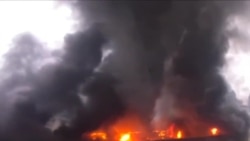Two days after the battles in Grozny between Chechen security personnel and militants claiming to act at the behest of Chechen insurgency wing commander Khamzat (Aslan Byutukayev), the North Caucasus insurgency leadership still has not formally claimed responsibility for the attack or clarified its objective. It has hitherto been accepted practice that such a claim of responsibility would be posted within days on one of the insurgency websites.
Just hours after the first shots were fired early on December 4, a two-minute video clip was posted on YouTube in which a man claiming to be one of the fighters at large in Grozny identified them as having pledged loyalty to Ali Abu-Muhammad, the Avar theologian who was chosen as early this year to succeed Doku Umarov as Caucasus Emirate leader.
Speaking in Chechen, the man said that "many" fighters had penetrated the city on orders from Amir Khamzat, and had already killed "many" of the enemy, destroyed vehicles, and seized larger quantities of weaponry than they could carry away. But in an implicit contradiction, he also said this was a suicide mission and "we shall fight to the death."
Chechen parliament speaker Dukvakha Abdurakhmanov dismissed that video and other footage filmed by Grozny residents as fakes "filmed far from Grozny and long before today."
The speaker in the video footage did not mention either of the two buildings the fighters occupied: the main press building and a school a few blocks away. That raises the question whether seizing the buildings was part of the original battle plan or, as the daily "Kommersant" suggests, a spontaneous decision after the vehicles in which some of the fighters were traveling were flagged down by traffic police with whom they then exchanged fire. Unconfirmed reports claim separate groups of fighters also tried to occupy the Grozny university building and the State Drug Control Agency.
According to “Kommersant,” the fighters who occupied the two buildings were planning to rendez-vous with comrades in arms in Grozny’s northern Staropromyslovsky district in order to carry out a large-scale attack. It seems equally plausible, however, that the occupation of two buildings close to each other in the city center was a deliberate diversion intended to concentrate the largest number of security personnel there for the longest possible time period to enable other fighters to attack secondary targets elsewhere in the city. The reports that gunfire continued in more than one location for several hours after the gunbattles at the press building and school were over suggests that this is indeed what happened, even though the Chechen authorities have not confirmed that fighting took place elsewhere in the city.
Speaking late on December 5, Chechen Republic head Ramzan Kadyrov gave a total casualty figure of 14 police and security personnel killed and 36 wounded. The previous evening, Russia's National Antiterror Committee had cited a figure of 10 killed and 28 wounded. It is not clear whether either or both sets of figures refer only to casualties in the initial shootout when police sought to intercept the fighters and in the subsequent fighting in which the militants reportedly deployed mortars and grenade throwers, or whether the larger figure also includes casualties incurred during fighting elsewhere in the city.
In a similar attack on Grozny in August 2004, a detachment of up to 400 Chechen resistance fighters killed 54 police and security personnel before withdrawing.
Whether or not the December 4 attack proceeded strictly according to plan, it accomplished at least four important objectives.
First, it demonstrated that the Chechen insurgency wing is still a force to be reckoned with, even after Umarov's death, and notwithstanding militants' failure to stage the widely anticipated terrorist attack(s) on the Sochi Winter Olympic Games in February.
Second, it has demolished Kadyrov's repeated assertions that no more than a handful of militants remain in Chechnya. When the fighting began in the small hours of December 4, Kadyrov's first reaction was to argue that the participants must have entered Chechnya from one of the neighboring republics, as the Chechen insurgency wing was no longer strong enough to undertake such an attack. The following day, he claimed the attack was organized by Umarov's brother Akhmat. Kadyrov said he will seek Akhmat Umarov's extradition from Turkey, where according to Kadyrov he currently lives.
While Kadyrov and other Chechen officials seek to give the impression that the fighters numbered no more than a dozen (11 bodies have reportedly been recovered, seven of them from the press building), Grozny residents estimate the total number of militants involved at 100-300. But even if there were only 80-100 of them, it is logical to assume that the total Chechen insurgency man-power is at least three times that number, and possibly more: No sane commander would risk deploying his entire army in an attack of that kind.
Third, by seizing the nine-story press building and the school at an hour when they were empty, the occupying fighters induced the Chechen security forces to use against them heavy artillery that effectively wrecked both structures. In addition, the Berkat market close to the press building was severely damaged by fire.
And fourth, assuming that the seizure of the two buildings was intended purely as a diversion, it provided the fighters who engaged in gunbattles with police and security personnel elsewhere in the city with valuable experience in urban warfare. They may also have replenished their arsenal, as the speaker in the video footage claimed.
In that respect, it is conceivable that the December 4 attack was intended simply as a trial run. In video footage uploaded in August, veteran Chechen commander Makhran Saidov said that "today we are not strong enough to liberate the city [of Grozny], but we believe that tomorrow we shall have [the necessary] strength."
-- Liz Fuller








